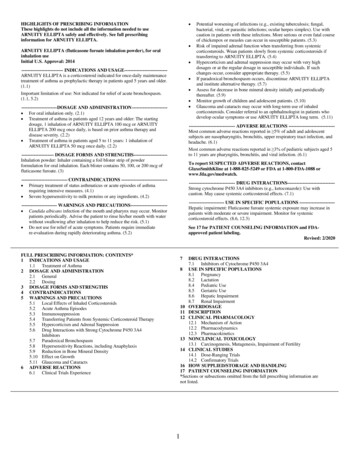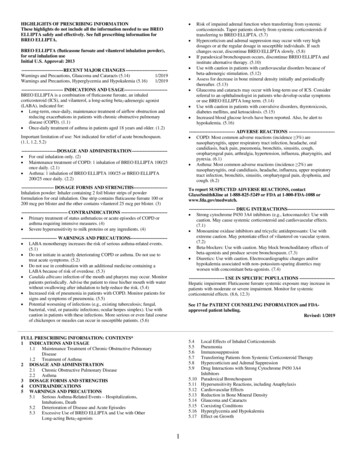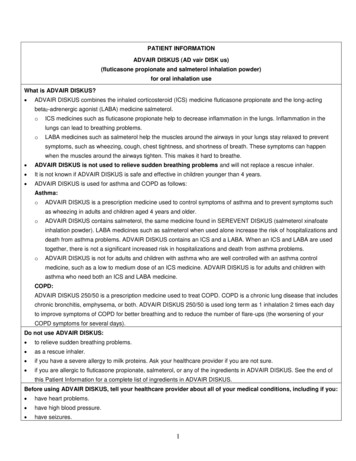
Transcription
HIGHLIGHTS OF PRESCRIBING INFORMATIONThese highlights do not include all the information needed to useARNUITY ELLIPTA safely and effectively. See full prescribinginformation for ARNUITY ELLIPTA. ARNUITY ELLIPTA (fluticasone furoate inhalation powder), for oralinhalation useInitial U.S. Approval: 2014 --------------------------- INDICATIONS AND USAGE---------------------------ARNUITY ELLIPTA is a corticosteroid indicated for once-daily maintenancetreatment of asthma as prophylactic therapy in patients aged 5 years and older.(1.1) Important limitation of use: Not indicated for relief of acute bronchospasm.(1.1, 5.2) ----------------------- DOSAGE AND ADMINISTRATION ---------------------- For oral inhalation only. (2.1) Treatment of asthma in patients aged 12 years and older: The startingdosage, 1 inhalation of ARNUITY ELLIPTA 100 mcg or ARNUITYELLIPTA 200 mcg once daily, is based on prior asthma therapy anddisease severity. (2.2) Treatment of asthma in patients aged 5 to 11 years: 1 inhalation ofARNUITY ELLIPTA 50 mcg once daily. (2.2)Potential worsening of infections (e.g., existing tuberculosis; fungal,bacterial, viral, or parasitic infections; ocular herpes simplex). Use withcaution in patients with these infections. More serious or even fatal courseof chickenpox or measles can occur in susceptible patients. (5.3)Risk of impaired adrenal function when transferring from systemiccorticosteroids. Wean patients slowly from systemic corticosteroids iftransferring to ARNUITY ELLIPTA. (5.4)Hypercorticism and adrenal suppression may occur with very highdosages or at the regular dosage in susceptible individuals. If suchchanges occur, consider appropriate therapy. (5.5)If paradoxical bronchospasm occurs, discontinue ARNUITY ELLIPTAand institute alternative therapy. (5.7)Assess for decrease in bone mineral density initially and periodicallythereafter. (5.9)Monitor growth of children and adolescent patients. (5.10)Glaucoma and cataracts may occur with long-term use of inhaledcorticosteroids. Consider referral to an ophthalmologist in patients whodevelop ocular symptoms or use ARNUITY ELLIPTA long term. (5.11)------------------------------ ADVERSE REACTIONS -----------------------------Most common adverse reactions reported in 5% of adult and adolescentsubjects are nasopharyngitis, bronchitis, upper respiratory tract infection, andheadache. (6.1)Most common adverse reactions reported in 3% of pediatric subjects aged 5to 11 years are pharyngitis, bronchitis, and viral infection. (6.1)--------------------- DOSAGE FORMS AND STRENGTHS---------------------Inhalation powder: Inhaler containing a foil blister strip of powderformulation for oral inhalation. Each blister contains 50, 100, or 200 mcg offluticasone furoate. (3)To report SUSPECTED ADVERSE REACTIONS, contactGlaxoSmithKline at 1-888-825-5249 or FDA at 1-800-FDA-1088 --- CONTRAINDICATIONS ----------------------------- Primary treatment of status asthmaticus or acute episodes of asthmarequiring intensive measures. (4.1) Severe hypersensitivity to milk proteins or any ingredients. (4.2)------------------------------ DRUG INTERACTIONS------------------------------Strong cytochrome P450 3A4 inhibitors (e.g., ketoconazole): Use withcaution. May cause systemic corticosteroid effects. (7.1)----------------------- USE IN SPECIFIC POPULATIONS ----------------------Hepatic impairment: Fluticasone furoate systemic exposure may increase inpatients with moderate or severe impairment. Monitor for systemiccorticosteroid effects. (8.6, 12.3)----------------------- WARNINGS AND PRECAUTIONS----------------------- Candida albicans infection of the mouth and pharynx may occur. Monitorpatients periodically. Advise the patient to rinse his/her mouth with waterwithout swallowing after inhalation to help reduce the risk. (5.1) Do not use for relief of acute symptoms. Patients require immediatere-evaluation during rapidly deteriorating asthma. (5.2)See 17 for PATIENT COUNSELING INFORMATION and FDAapproved patient labeling.Revised: 2/2020FULL PRESCRIBING INFORMATION: CONTENTS*1 INDICATIONS AND USAGE1.1 Treatment of Asthma2 DOSAGE AND ADMINISTRATION2.1 General2.2 Dosing3 DOSAGE FORMS AND STRENGTHS4 CONTRAINDICATIONS5 WARNINGS AND PRECAUTIONS5.1 Local Effects of Inhaled Corticosteroids5.2 Acute Asthma Episodes5.3 Immunosuppression5.4 Transferring Patients from Systemic Corticosteroid Therapy5.5 Hypercorticism and Adrenal Suppression5.6 Drug Interactions with Strong Cytochrome P450 3A4Inhibitors5.7 Paradoxical Bronchospasm5.8 Hypersensitivity Reactions, including Anaphylaxis5.9 Reduction in Bone Mineral Density5.10 Effect on Growth5.11 Glaucoma and Cataracts6 ADVERSE REACTIONS6.1 Clinical Trials Experience7DRUG INTERACTIONS7.1 Inhibitors of Cytochrome P450 3A48 USE IN SPECIFIC POPULATIONS8.1 Pregnancy8.2 Lactation8.4 Pediatric Use8.5 Geriatric Use8.6 Hepatic Impairment8.7 Renal Impairment10 OVERDOSAGE11 DESCRIPTION12 CLINICAL PHARMACOLOGY12.1 Mechanism of Action12.2 Pharmacodynamics12.3 Pharmacokinetics13 NONCLINICAL TOXICOLOGY13.1 Carcinogenesis, Mutagenesis, Impairment of Fertility14 CLINICAL STUDIES14.1 Dose-Ranging Trials14.2 Confirmatory Trials16 HOW SUPPLIED/STORAGE AND HANDLING17 PATIENT COUNSELING INFORMATION*Sections or subsections omitted from the full prescribing information arenot listed.1
FULL PRESCRIBING INFORMATION1INDICATIONS AND USAGE1.1Treatment of AsthmaARNUITY ELLIPTA is indicated for the once-daily maintenance treatment of asthma asprophylactic therapy in patients aged 5 years and older.Important Limitation of UseARNUITY ELLIPTA is NOT indicated for the relief of acute bronchospasm.2DOSAGE AND ADMINISTRATION2.1GeneralARNUITY ELLIPTA should be administered only by the orally inhaled route [see Instructionsfor Use leaflet]. After inhalation, the patient should rinse his/her mouth with water withoutswallowing to help reduce the risk of oropharyngeal candidiasis.If symptoms arise between doses, an inhaled, short-acting beta2-agonist should be used forimmediate relief.The maximum benefit may not be achieved for up to 2 weeks or longer after starting treatment.Individual patients may experience a variable time to onset and degree of symptom relief.2.2DosingARNUITY ELLIPTA should be administered as 1 inhalation once daily by the orally inhaledroute. ARNUITY ELLIPTA should be used at the same time every day. Do not use ARNUITYELLIPTA more than 1 time every 24 hours.Adults and Adolescents Aged 12 Years and OlderThe starting dosage for ARNUITY ELLIPTA should be based upon patients’ asthma severity.The usual recommended starting dose for adults and adolescents aged 12 years and older not onan inhaled corticosteroid (ICS) is 100 mcg. For other adults and adolescents aged 12 years andolder, the starting dose should be based on previous asthma drug therapy and disease severity.For adults and adolescents aged 12 years and older who do not respond to ARNUITY ELLIPTA100 mcg after 2 weeks of therapy, replacement with ARNUITY ELLIPTA 200 mcg may provideadditional asthma control.If a dosage regimen of ARNUITY ELLIPTA fails to provide adequate control of asthma, thetherapeutic regimen should be re-evaluated and additional therapeutic options, e.g., replacing thecurrent strength of ARNUITY ELLIPTA with a higher strength, initiating an ICS andlong-acting beta2-agonist (LABA) combination product, or initiating oral corticosteroids, shouldbe considered.2
The highest recommended daily dose in adults and adolescents aged 12 years and older is200 mcg.After asthma stability has been achieved, it is desirable to titrate to the lowest effective dosage tohelp reduce the possibility of side effects.Pediatric Patients Aged 5 to 11 YearsThe recommended dosage for children aged 5 to 11 years is 50 mcg administered once daily [seeWarnings and Precautions (5.10)].3DOSAGE FORMS AND STRENGTHSInhalation powder: Disposable light grey and orange plastic inhaler containing a foil blister stripof powder intended for oral inhalation only. Each blister contains fluticasone furoate 50, 100, or200 mcg.4CONTRAINDICATIONSThe use of ARNUITY ELLIPTA is contraindicated in the following conditions: Primary treatment of status asthmaticus or other acute episodes of asthma where intensivemeasures are required [see Warnings and Precautions (5.2)]. Severe hypersensitivity to milk proteins or demonstrated hypersensitivity to fluticasonefuroate or any of the excipients [see Warnings and Precautions (5.8), Description (11)].5WARNINGS AND PRECAUTIONS5.1Local Effects of Inhaled CorticosteroidsIn clinical trials, the development of localized infections of the mouth and pharynx with Candidaalbicans has occurred in subjects treated with ARNUITY ELLIPTA. When such an infectiondevelops, it should be treated with appropriate local or systemic (i.e., oral) antifungal therapywhile treatment with ARNUITY ELLIPTA continues, but at times therapy with ARNUITYELLIPTA may need to be interrupted. Advise the patient to rinse his/her mouth with waterwithout swallowing following inhalation to help reduce the risk of oropharyngeal candidiasis.5.2Acute Asthma EpisodesARNUITY ELLIPTA is not indicated for the relief of acute symptoms, i.e., as rescue therapy fortreatment of acute episodes of bronchospasm. ARNUITY ELLIPTA has not been studied in therelief of acute symptoms and extra doses should not be used for that purpose. Acute symptomsshould be treated with an inhaled, short-acting beta2-agonist. Instruct patients to contact theirphysicians immediately if episodes of asthma not responsive to bronchodilators occur during thecourse of treatment with ARNUITY ELLIPTA. During such episodes, patients may requiretherapy with oral corticosteroids.3
5.3ImmunosuppressionPersons who are using drugs that suppress the immune system are more susceptible to infectionsthan healthy individuals. Chickenpox and measles, for example, can have a more serious or evenfatal course in susceptible children or adults using corticosteroids. In such children or adults whohave not had these diseases or been properly immunized, particular care should be taken to avoidexposure. How the dose, route, and duration of corticosteroid administration affect the risk ofdeveloping a disseminated infection is not known. The contribution of the underlying diseaseand/or prior corticosteroid treatment to the risk is also not known. If a patient is exposed tochickenpox, prophylaxis with varicella zoster immune globulin (VZIG) or pooled intravenousimmunoglobulin (IVIG) may be indicated. If a patient is exposed to measles, prophylaxis withpooled intramuscular immunoglobulin (IG) may be indicated. (See the respective package insertsfor complete VZIG, IVIG, and IG prescribing information.) If chickenpox develops, treatmentwith antiviral agents may be considered.ICS should be used with caution, if at all, in patients with active or quiescent tuberculosisinfections of the respiratory tract; untreated systemic fungal, bacterial, viral, or parasiticinfections; or ocular herpes simplex.5.4Transferring Patients from Systemic Corticosteroid TherapyParticular care is needed for patients who have been transferred from systemically activecorticosteroids to ICS because deaths due to adrenal insufficiency have occurred in patients withasthma during and after transfer from systemic corticosteroids to less systemically available ICS.After withdrawal from systemic corticosteroids, a number of months are required for recovery ofhypothalamic-pituitary-adrenal (HPA) function.Patients who have been previously maintained on 20 mg or more of prednisone (or itsequivalent) may be most susceptible, particularly when their systemic corticosteroids have beenalmost completely withdrawn. During this period of HPA suppression, patients may exhibit signsand symptoms of adrenal insufficiency when exposed to trauma, surgery, or infection(particularly gastroenteritis) or other conditions associated with severe electrolyte loss. AlthoughARNUITY ELLIPTA may control asthma symptoms during these episodes, in recommendeddoses it supplies less than normal physiological amounts of glucocorticoid systemically and doesNOT provide the mineralocorticoid activity that is necessary for coping with these emergencies.During periods of stress or a severe asthma attack, patients who have been withdrawn fromsystemic corticosteroids should be instructed to resume oral corticosteroids (in large doses)immediately and to contact their physicians for further instruction. These patients should also beinstructed to carry a warning card indicating that they may need supplementary systemiccorticosteroids during periods of stress or a severe asthma attack.Patients requiring oral corticosteroids should be weaned slowly from systemic corticosteroid useafter transferring to ARNUITY ELLIPTA. Prednisone reduction can be accomplished by4
reducing the daily prednisone dose by 2.5 mg on a weekly basis during therapy with ARNUITYELLIPTA. Lung function (forced expiratory volume in 1 second [FEV1] or peak expiratory flow[PEF]), beta-agonist use, and asthma symptoms should be carefully monitored during withdrawalof oral corticosteroids. In addition, patients should be observed for signs and symptoms ofadrenal insufficiency, such as fatigue, lassitude, weakness, nausea and vomiting, andhypotension.Transfer of patients from systemic corticosteroid therapy to ARNUITY ELLIPTA may unmaskallergic conditions previously suppressed by the systemic corticosteroid therapy (e.g., rhinitis,conjunctivitis, eczema, arthritis, eosinophilic conditions).During withdrawal from oral corticosteroids, some patients may experience symptoms ofsystemically active corticosteroid withdrawal (e.g., joint and/or muscular pain, lassitude,depression), despite maintenance or even improvement of respiratory function.5.5Hypercorticism and Adrenal SuppressionARNUITY ELLIPTA will often help control asthma symptoms with less suppression of HPAfunction than therapeutically equivalent oral doses of prednisone. Since ARNUITY ELLIPTA isabsorbed into the circulation and can be systemically active at higher doses, the beneficial effectsof ARNUITY ELLIPTA in minimizing HPA dysfunction may be expected only whenrecommended dosages are not exceeded and individual patients are titrated to the lowesteffective dose.Because of the possibility of significant systemic absorption of ICS in sensitive patients, patientstreated with ARNUITY ELLIPTA should be observed carefully for any evidence of systemiccorticosteroid effects. Particular care should be taken in observing patients postoperatively orduring periods of stress for evidence of inadequate adrenal response.It is possible that systemic corticosteroid effects such as hypercorticism and adrenal suppression(including adrenal crisis) may appear in a small number of patients, particularly when fluticasonefuroate is administered at higher than recommended doses over prolonged periods of time. Ifsuch effects occur, the dosage of ARNUITY ELLIPTA should be reduced slowly, consistentwith accepted procedures for reducing systemic corticosteroids and for management of asthmasymptoms.5.6Drug Interactions with Strong Cytochrome P450 3A4 InhibitorsCaution should be exercised when considering the coadministration of ARNUITY ELLIPTAwith ketoconazole and other known strong CYP3A4 inhibitors (e.g., ritonavir, clarithromycin,conivaptan, indinavir, itraconazole, lopinavir, nefazodone, nelfinavir, saquinavir, telithromycin,troleandomycin, voriconazole) because increased systemic corticosteroid adverse effects mayoccur [see Drug Interactions (7.1), Clinical Pharmacology (12.3)].5
5.7Paradoxical BronchospasmAs with other inhaled medicines, ARNUITY ELLIPTA can produce paradoxical bronchospasm,which may be life threatening. If paradoxical bronchospasm occurs following dosing withARNUITY ELLIPTA, it should be treated immediately with an inhaled, short-actingbronchodilator; ARNUITY ELLIPTA should be discontinued immediately; and alternativetherapy should be instituted.5.8Hypersensitivity Reactions, including AnaphylaxisHypersensitivity reactions such as urticaria, flushing, allergic dermatitis, and bronchospasm mayoccur after administration of ARNUITY ELLIPTA. Discontinue ARNUITY ELLIPTA if suchreactions occur. There have been reports of anaphylactic reactions in patients with severe milkprotein allergy after inhalation of other powder medications containing lactose; therefore,patients with severe milk protein allergy should not use ARNUITY ELLIPTA [seeContraindications (4.2)].5.9Reduction in Bone Mineral DensityDecreases in bone mineral density (BMD) have been observed with long-term administration ofproducts containing ICS. The clinical significance of small changes in BMD with regard tolong-term consequences such as fracture is unknown. Patients with major risk factors fordecreased bone mineral content, such as prolonged immobilization, family history ofosteoporosis, postmenopausal status, tobacco use, advanced age, poor nutrition, or chronic use ofdrugs that can reduce bone mass (e.g., anticonvulsants, oral corticosteroids) should be monitoredand treated with established standards of care.5.10Effect on GrowthOrally inhaled corticosteroids, including ARNUITY ELLIPTA, may cause a reduction in growthvelocity when administered to children and adolescents. Monitor the growth of children andadolescents receiving ARNUITY ELLIPTA routinely (e.g., via stadiometry). To minimize thesystemic effects of orally inhaled corticosteroids, including ARNUITY ELLIPTA, titrate eachpatient’s dose to the lowest dosage that effectively controls his/her symptoms [see Dosage andAdministration (2.2), Use in Specific Populations (8.4)].5.11Glaucoma and CataractsGlaucoma, increased intraocular pressure, and cataracts have been reported in patients withasthma following the long-term administration of ICS, including fluticasone furoate. Considerreferral to an ophthalmologist in patients who develop ocular symptoms or use ARNUITYELLIPTA long term.6ADVERSE REACTIONSSystemic and local corticosteroid use may result in the following:6
Candida albicans infection [see Warnings and Precautions (5.1)] Immunosuppression [see Warnings and Precautions (5.3)] Hypercorticism and adrenal suppression [see Warnings and Precautions (5.5)] Reduction in BMD [see Warnings and Precautions (5.9)] Growth effects in pediatrics [see Warnings and Precautions (5.10)] Glaucoma and cataracts [see Warnings and Precautions (5.11)]6.1Clinical Trials ExperienceBecause clinical trials are conducted under widely varying conditions, adverse reaction ratesobserved in the clinical trials of a drug cannot be directly compared with rates in the clinicaltrials of another drug and may not reflect the rates observed in practice.Adult and Adolescent Subjects Aged 12 Years and OlderThe safety of ARNUITY ELLIPTA was evaluated in 10 double-blind, parallel-group, controlledtrials (7 with placebo) of 8 to 76 weeks’ duration that enrolled 6,219 subjects with asthma. Dosesof fluticasone furoate studied ranged from 25 to 800 mcg.ARNUITY ELLIPTA 100 mcg was studied in 1,663 subjects, and ARNUITY ELLIPTA200 mcg was studied in 608 subjects. Subject ages ranged from 12 to 84 years, 65% were female,and 75% were Caucasian.In these trials, the proportion of subjects who discontinued study treatment early due to adversereactions was 2% for subjects treated with both ARNUITY ELLIPTA 100 mcg and ARNUITYELLIPTA 200 mcg and 1% for placebo-treated subjects. Serious adverse events, whetherconsidered drug-related or not by the investigators, that occurred in more than 1 subject and in agreater percentage of subjects treated with ARNUITY ELLIPTA than placebo includedhypertension, abscess, breast cancer, traumatic limb amputation, subarachnoid hemorrhage, andintervertebral disc protrusion; all events occurred at rates 1%.The incidence of adverse reactions associated with ARNUITY ELLIPTA 100 mcg is shown inTa
-----DOSAGE AND ADMINISTRATION----- For oral inhalation only. (2.1) Treatment of asthma in patients aged 12 years and older: The starting dosage, 1 inhalation of ARNUITY ELLIPTA 100 mcg or ARNUITY ELLIPTA 200 mcg once daily, is











